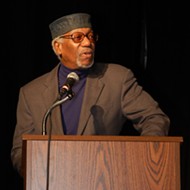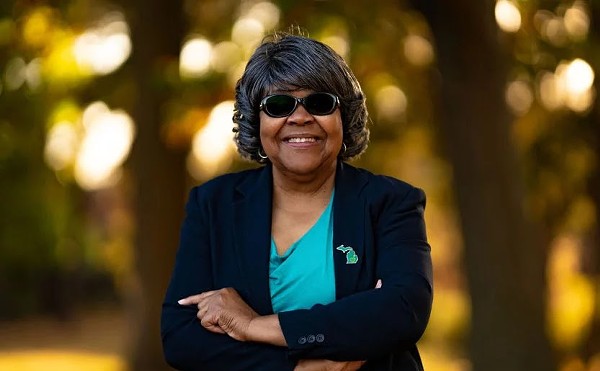Sergeant Willie Bell is tall and whippet-thin. His head is clean-shaven and a thick Fu Manchu moustache folds neatly around his mouth. There’s an athletic quickness in his long strides as he moves to his desk.
From a distance his image is tough, almost menacing, like a certain welterweight champion. All of his apparent ice-cold exterior slowly dissolves, however, when he speaks. The words are soft and carefully articulated. “When I joined police force back in 1971 there was no affirmative action program. Minority officers represented but a small percentage of the total force. At that time, Blacks and females could not have been more than twenty percent.”
Bell, who is president of the Guardians of Michigan, a 500-member Black police officers association, then recalled the gains made since Mayor Coleman Young instituted his affirmative action plans in 1974. “Before Coleman became mayor there were few Blacks in the higher ranks. Before Coleman, affirmative action was only a token activity.”
Bell feels that the recent layoff of 7OO police officers, 75 percent of whom are Black and 40 Percent of whom are women, as well as the DPOA’s refusal to discuss alternative layoff plans proposed by the mayor, has sharpened the differences between the two police associations.
***
From the television screen and photos, David Watroba seems squat and a bit pudgy. His stringy blond hair is thinning and is swept deliberately to the right of his head. His manner is serious and his face holds a firm, no-nonsense | expression when he speaks.
“Can you imagine the hostility,” he intones, discussing the recent layoffs, “if the police would have been laid off without using the seniority rule?” Like Bell, he carefully measurers each word. “In my opinion ^affirmative action is still intact. Minority officers still make-up over twenty percent of the force.”
Watroba, who is running for re-election as president of the 3700-mernber DPOA, places the blame for the layoffs squarely on the city, (he avoids using the mayor’s name): “With 1,090 Detroit police officers laid-off, it is unbelievable that the Detroit media — radio, TV and the newspapers — are concentrating on who is laid-off instead of why they are laid-off … it (the media) has attempted to convince the public that the decision to layoff police officers was made by the DPOA. We all know that that decision was made by the City.”
1973 B.C.
To properly understand the opponents and their positions, and the role of the city in this swelling controversy, a short in this swelling controversy’ a short discussion of Detroit police history is required. This background lesson has but two simple phases: the minority police status before Coleman Young became mayor, a period
called by some Black police officers as the B.C period, or Before Coleman. And the period since 1974 when the mayor enacted his plans for affirmative action.
During the so-called B.C. period, Black and female police officers never constituted more than twenty percent of the police force. In 1963, the year the Guardians was founded, according to Sergeant Mackie Johnson, a 28-year veteran of the police force and the Guardians founder-historian, “there were only 130 Black police officers in all Detroit, Highland Park, River Rouge, Oak Park and Wayne County. Only after the disturbance of 1967 was there a real concern to improve the number of minority police officers here in the city.”
Mayor Young recalls in Studs Terkel’s latest book, American Dreams: Lost & Found, that “when I was elected (in 1373), only 15 percent of the police force was Black.” Additionally, in the same year, there were only I4O women in uniform. In I973-74 Detroit’s police force was more than 3,000 strong.”
This was a time when the Black community was incensed by the brutal effects of the Police department’s STRESS (Stop the Robberies and Enjoy Safe Streets) and its violent deco/ operations, which in a two year period (1971-72) had 22 Black killings to its credit. John Nichols, Police Commissioner under Mayor Roman Gribbs, was Young’s opponent in the runoff for mayor.
AFFIRMATIVE ACTION BEGINS
Young’s well-run campaign and the solid backing from the community — including a coalition of white liberals, Black nationalists and many of the city’s corporate elite — proved decisive and Nichols was defeated in a close race. Wasting little time, the new mayor almost immediately set his plans for affirmative action in motion. The city, according to Mayor Young, had a majority Black population and the police department would reflect the same racial composition.
Naturally, the DPOA was angered by these plans and took its grievance directly to court. While the issue stewed in court, Young went ahead with his plans and by 1977, it was estimated that between 26 and 28 percent of the department’s officers were either Black or women. A recent estimate, taken just prior to the September layoff of 700 officers, put the figures between 35 and 40 percent minority.
And it has been the recent layoffs which have triggered or renewed the three-way struggle between the Mayor’s office, the DPOA and the Guardians. The scenario of events reads like a vicious circle: To improve the racial composition of the Police Department the mayor launches an affirmative action program; affirmative action is challenged by the DPOA in court and, through state arbitration, wins a 51 million dollar settlement; the city, already facing a budget deficit of over 100 million dollars, is forced to lay off police officers; the Guardians are upset because, according to the DPOA’s seniority rule, the majority of the officers to be laid-off had to be those most recently hired-Blacks and females.
Of course, from the mayor’s point of view the real culprit in the whole nasty affair, and the reason the city’s budget is so strained, are the salary increases that had to be given to the police officers as result of the state arbitration decision. Detroit’s police,” the mayor noted, “are among the highest paid in the nation.” “I don’t think they deserve the pay raise they’re gettin’.”
Watroba and the DPOA see all the mayor’s budget woes from quite a different perspective. “Since last fall, Watroba notes,
this Union has made an extra determined effort to warn the Detroit community that the city was operating on a ‘Cadillac’ budget while having money only” for a Chevette.”
DPOA RESPONDS
Over the last few months the DPOA has taken out full page ads in the local dailies and have issued flyers depicting Joe Louis Arena as — THE MONSTER THATDEVOURED DETROIT POLICE. It
is the DPOA’s contention that all the money spent to build the arena could have been used to pay police officers. “We think it is good for Detroit to have a new arena,” the flyer announces, “…but we value the safely of each Detroiter even more.”
Bell feels that the heavy layoffs of minority police not only erodes the gains made through affirmative action, but also undermines the improved relationship between police and the community. “With the hiring of more minority officers, including women, police-community relations experienced a radical turnaround,” said Bell. “even the incidence of police brutality was lowered. In 1979, for example, the number of complaints against the police declined. Now, with the layoffs and everything, I’m afraid we’re on our way back to the early seventies, when the community, the Black community in particular, viewed the police as no more than a white occupation army.”
Such incidents as the Miami rebellion and the recent disturbance in Philadelphia, each an outgrowth of police brutality, are poignant lessons of just what that kind of situation can lead to.
To avert such dangerous deterioration of community relations the mayor proposed two plans to the DPOA. One plan called for the use of a dual-list in which white officers would be ranked by seniority on one list, Blacks and females on a second list, and have the layoffs be shared equally between the two groups. The second proposal would have cancelled all layoffs and instituted instead a 13.8 percent reduction in the police payroll. No one was surprised when the DPOA failed to respond to either proposal.
GUARDIANS INITIATE SUIT
Earlier this month the Guardians, in addition to its demonstrations outside DPOA’s headquarters, filed a class action suit in federal court which seeks to overcome the Police Department’s seniority rule.
“The DPOA,” the suit reads, made no good-faith effort to prevent the layoffs because of its intent to discriminate against minority members … the DPOA has followed what has been its purposes over the years — fighting affirmative action. They have showed their true colors.”
“But despite the loses through layoffs,” said Johnson. “Detroit still has, comparatively
more minority officers than any other major city in the nation. Look at New York City where there are more than 25,000 officers. Well, in 1979, there were only five Black officers above the rank of captain.” Johnson also pointed out that Detroit’s Police Department, before the layoffs, had nearly 7Q0 women in uniform. By comparison, New York has only about 400 women in uniform.
Such comparisons, of course, mean little to the many laid-off police officers who feel that they may never be called back to work. Some are even considering relocating in Los Angeles and Atlanta where there is a reported shortage of qualified police applicants.
One laid-off officer, who chose to remain anonymous, suggested that if the residency rule was enforced “… it would create at least 500 jobs for laid off officers.” He knew of a hundred white police officers who did not live within the city limits.
At a recent membership meeting of the National Lawyers Guild, a panelist noted that “no officer had ever been fired over the issue of residency.” And this practice, according to the speaker, has been allowed to continue because most cases of this sort go before an all white male review board.
Of deeper significance for Detroit attorney Richard Soble, president of the National Lawyers Guild and also a panelist on a discussion of police misconduct, was the anticipated increase in police brutality which, in his opinion, was sure to follow the layoff of so many officers.
If such a crisis is to be averted, in the words of yet another anonymous, laid-off Black police officer, “Watroba, Bell aid the mayor are simply going to have to sit down and seriously pursue a plan that will consider the merits of both affirmative action and the seniority rule.”
[
{
"name": "GPT - Leaderboard - Inline - Content",
"component": "35519556",
"insertPoint": "5th",
"startingPoint": "3",
"requiredCountToDisplay": "3",
"maxInsertions": 100
}
]






